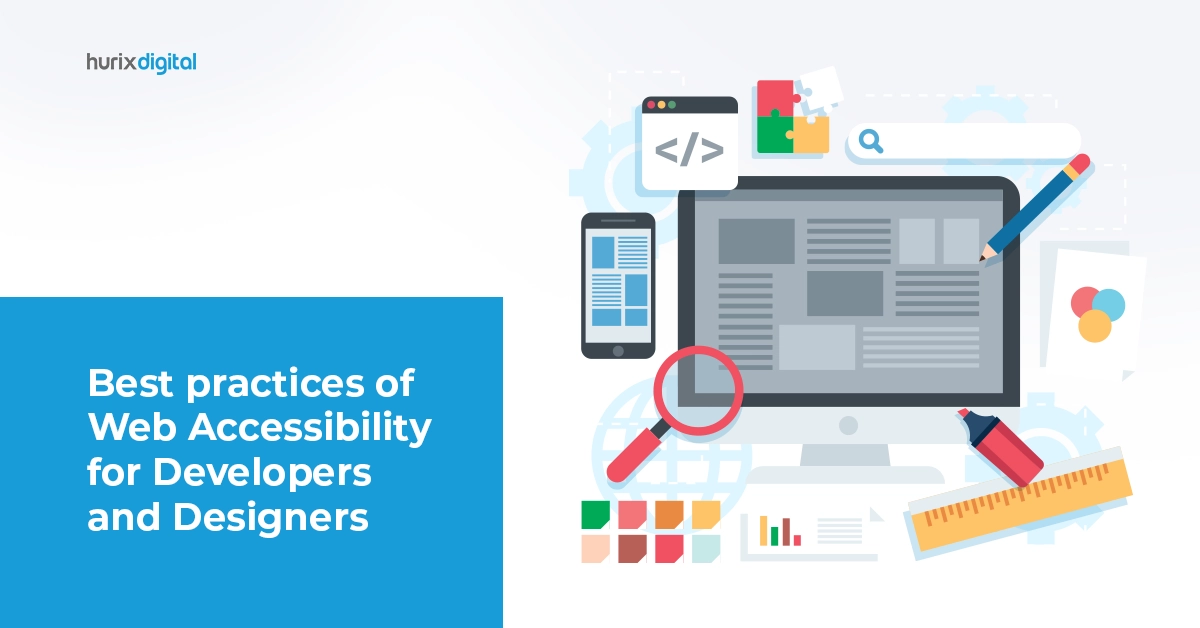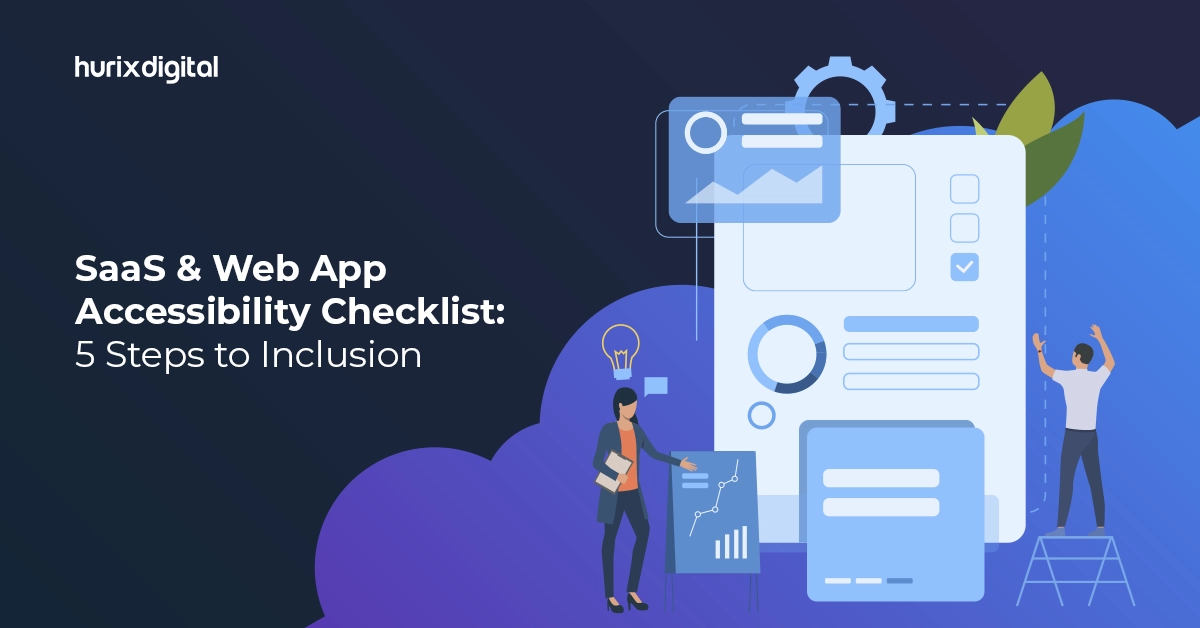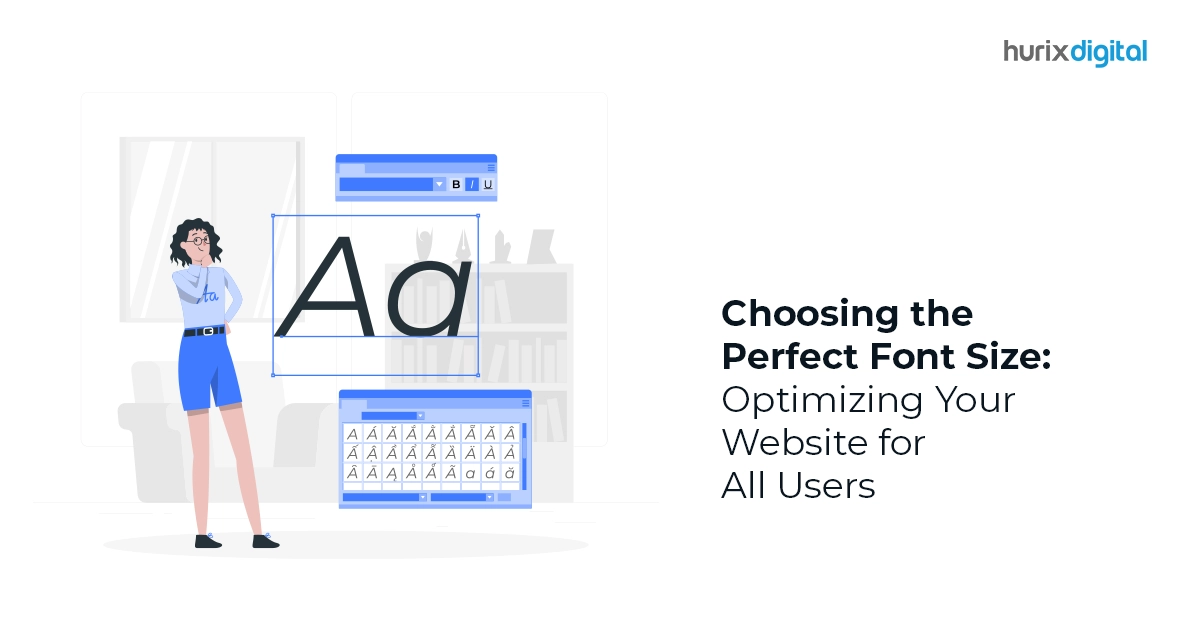Summary
This blog addresses challenges faced by individuals with disabilities and provides best practices, such as creating alternative text for images, designing clear links, ensuring color contrast, and prioritizing keyboard navigation. The key takeaway is that web accessibility is a moral and legal imperative, promoting a more equitable and accessible digital environment for everyone.
Table of Contents:
- Five Challenges That Individuals With Disabilities Face
1. Provide Alternative Text for Images
2. Create Clear and Descriptive Links
3. Ensure Proper Color Contrast
4. Design with Keyboard Navigation in Mind
5. Use Semantic HTML Markup and Headings - Understanding the Importance of Web Accessibility
- Key Web Accessibility Best Practices for Developers and Designers
- Accessibility Website Testing and Web Compliance
- Web Accessibility Solution Providers
- Bottom Line
Imagine visiting a website and not being able to navigate it due to a screen reader incompatibility or struggling to decipher poorly contrasted text. These are just a few challenges that individuals with disabilities face. By making your websites accessible, you can ensure equal access and inclusion for everyone. Put yourself in the shoes of users with disabilities and understand their unique needs and challenges when interacting with your website.
Five Challenges That Individuals With Disabilities Face
1. Provide Alternative Text for Images:
Think of images as visual content that can tell a story or convey important information. However, for users who are visually impaired or rely on assistive technologies, images need alternative text descriptions to understand their context. For instance, if you have an image showcasing a product, include alt text that describes the product’s features and benefits. This way, screen readers can accurately convey the information to visually impaired users.
2. Create Clear and Descriptive Links:
Links are essential for navigating websites. When creating links, avoid using generic phrases like “click here” or “read more.” Instead, make them descriptive and informative, providing users with a clear understanding of the link’s destination. This is particularly helpful for users who rely on assistive technologies, such as screen readers, which present a list of links on a page.
3. Ensure Proper Color Contrast:
Color plays a significant role in web design, but it can pose challenges for users with visual impairments or color blindness. To ensure accessibility, use color combinations that provide sufficient contrast between the text and background. This makes it easier for all users to read and understand the content. Various online tools are available to check the contrast ratio and ensure compliance with accessibility standards.
4. Design with Keyboard Navigation in Mind:
Not all users can rely on a mouse or touchscreen to navigate websites. Some individuals with motor disabilities use keyboard-only navigation. Ensure that all interactive elements, such as buttons and links, can be accessed and activated using the keyboard alone. Test your website’s functionality by navigating through it using only the Tab key.
5. Use Semantic HTML Markup and Headings:
Proper HTML markup is crucial for web accessibility. Use semantic elements such as <nav>, <article>, and <section> to provide structure and meaning to your content. Properly structured headings (H1, H2, H3, etc.) help users navigate and understand the hierarchy of the content. This is particularly beneficial for screen reader users who rely on heading structure to skim through a page.
Throughout this blog, we’ve emphasized the importance of understanding the unique needs of individuals with disabilities. By putting ourselves in their shoes and considering their challenges, we can design and develop websites that provide equal access and a seamless user experience for everyone.
Read more: 5 Most Common Web Accessibility Issues to Avoid & Fix
Understanding the Importance of Web Accessibility:
Web accessibility aims to remove barriers that prevent individuals with disabilities from fully accessing and interacting with websites. By prioritizing web accessibility, developers and designers can enhance the user experience for people with disabilities, including those with visual impairments, hearing impairments, motor disabilities, cognitive disabilities, and more. In addition, creating accessible websites is not only a moral imperative but also a legal requirement in many jurisdictions.
Key Web Accessibility Best Practices for Developers and Designers:
1. Familiarize Yourself with WCAG:
The Web Content Accessibility Design Guidelines (WCAG) provide a comprehensive set of principles, guidelines, and success criteria for web accessibility. Developers and designers should familiarize themselves with WCAG 2.1 or the latest version (currently WCAG 2.2), which outlines specific techniques to achieve accessibility.
2. Structure and Semantic HTML:
Using proper HTML structure and semantic markup is crucial for accessibility. Ensure that headings, lists, and other elements are used appropriately to provide a logical and well-organized content hierarchy. This helps users navigate and understand the website’s structure more efficiently.
3. Meaningful and Accessible Links:
Make sure that hyperlinks are descriptive and meaningful when read out of context. Avoid generic phrases like “click here” and instead use descriptive text that conveys the purpose or destination of the link.
4. Provide Alternative Text for Images:
Adding alt text to images is essential for screen reader users to understand the content. The alt text should provide a concise and accurate description of the image, conveying its purpose or conveying relevant information.
5. Use ARIA Roles and Attributes:
Accessible Rich Internet Applications (ARIA) roles and attributes help enhance the accessibility of dynamic and interactive web elements. Utilize ARIA roles to communicate the purpose and behavior of components like menus, forms, and modal dialogs to assistive technologies.
6. Ensure Keyboard Accessibility:
Test your website’s functionality using only the keyboard. Ensure that all interactive elements, menus, and focus indicators are keyboard accessible and can be operated without the need for a mouse or other pointing devices.
7. Color Contrast and Visual Design:
Ensure sufficient color contrast between text and background colors to make content readable for users with visual impairments. Consider the use of other visual cues, such as icons and patterns, to convey information and enhance user understanding.
Read more: The Importance of Web Accessibility and How Hurix is Making a Difference
Accessibility website Testing and web Compliance:
Web accessibility testing is a crucial step in the development process. Conduct regular accessibility audits and use automated tools to identify accessibility issues. Additionally, perform manual testing and engage individuals with disabilities to provide feedback on the accessibility of your website.
While striving for accessibility, keep in mind that achieving full compliance can be a complex and ongoing process. However, the effort is well worth it as you contribute to an inclusive digital environment.
Web Accessibility Solution Providers:
If you require specialized assistance, several web accessibility solution providers offer tools and services to ensure compliance with accessibility standards. These solutions range from automated accessibility scans to comprehensive audits and consultancy services.
From providing alternative text for images to creating clear and descriptive links, each step we’ve covered contributes to making the web more inclusive. By ensuring proper color contrast and designing with keyboard navigation in mind, we empower users to navigate and interact with our websites regardless of their abilities. And let’s not forget the significance of semantic HTML markup and properly structured headings, which enable assistive technologies to interpret and present content accurately.
Read also: 7 Reasons Why You Must Consider Web Accessibility Solutions
Bottom Line:
As developers and designers, we have the power to shape the digital landscape and make a positive impact on people’s lives. By embracing web accessibility, we contribute to a more inclusive online world where everyone can access and engage with information and services.
So, let’s take what we’ve learned and integrate web accessibility into our design and development processes from the start. By seeking feedback, testing our websites with assistive technologies, and staying up to date with accessibility standards and web accessibility best practices, we can continuously improve and refine our websites’ accessibility.
Remember, web accessibility is an ongoing journey, and it requires a collaborative effort from all stakeholders involved in the website development process. By championing accessibility, we pave the way for a digital landscape that celebrates diversity and inclusivity.
Get in touch with Hurix for more details on our Web accessibility audit and remediation services.











